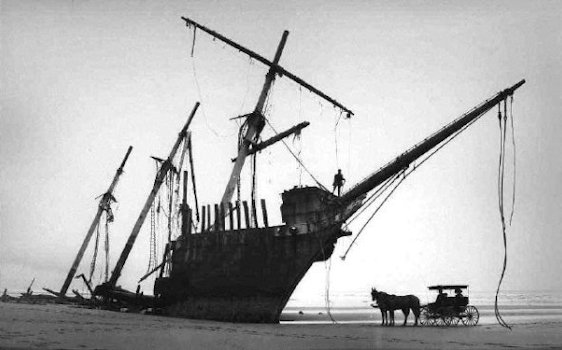
|
Peter Iredale at Fort Steven's State Park, Near Astoria, Oregon
23. Maritime Court Proceedings The "Peter Iredale" was a sailing vessel, four-masted steel barque, of 1,993 tons registered tonnage, official number 97790, and built at Maryport, England, in 1890, and belonging to the port of Liverpool, owners P. Iredale and Porter. In appears from the evidence given before the Court that the ship sailed from Salina Cruz, Mexico, on or about the 26th of September, 1906, with 1,000 tons of ballast, and a crew of 27 hands all told, including two stowaways. No incident worthy of mention happened until the lookout sighted the light on Tillamook Rock at 3.20 a.m. on the 25th of October 1906. The ship's course was altered to E.N.E. until the vessel was five miles off the light. The course was then altered to sight the Columbia River lightship. ⇦ Back to Page 22 On to Page 24 ⇨On to Fort Steven's Page 3 |
|
| Wreck of the Peter Iredale in 1906 | ||
|
This was sighted and recognized, it bearing N.E. In this position, finding the wind was veering to westward, and having lost sight of the light in a thick mist, it was decided to wear ship to avoid the influence of the current setting to the north, and the tide running into the Columbia River. The wind had now hauled to north of west in heavy squalls with rain. Just before striking, while in the act of wearing, an exceedingly heavy west northwest squall struck the vessel, throwing her head off, she taking the ground, and shortly afterwards losing her upper spars. She then drove ashore, with a high southwest sea running, and a fresh westerly gale. We consider that everything was done by the master to get his ship out of danger, but that the set of the current and the sudden shift of wind drove him so close in that in the act of wearing around to get his ship's head off shore, she stranded. The Court, having regard to the circumstances above stated, finds as follows: That the position of the ship before the shift of wind was not one of danger. She was in the usual cruising ground of the pilot schooner, but unfortunately no pilots were on the station, the pilot boat being in port under repairs. We consider that prompt action was taken by the master immediately the wind shifted, to get his ship's head off shore, and by all accounts he was ably seconded by his officers and men. Having carefully considered the evidence, we do find that the master, and his first and second officers, are in no wise to blame for the stranding of the said vessel, and their certificates having accordingly been returned to them. |
||